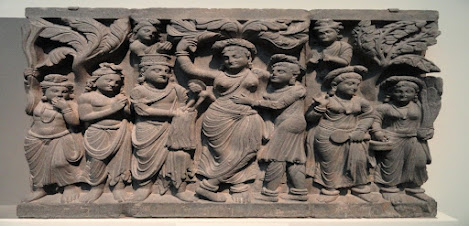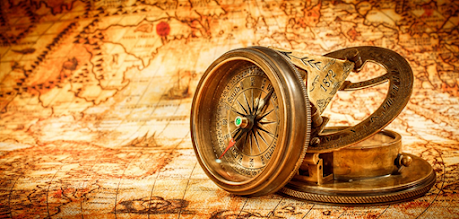The Kushan Empire
The period which began about 200 BC did not witness a large empire like that of the Mauryas, but it is notable for intimate and widespread contacts between Central Asia and India. In eastern India, the Central India and the Deccan the Mauryas were succeeded by a number of native rulers such as the Sungas, Kanvas and the Satavahans. In the North-western India they were succeeded by a number of ruling dynasties from Central Asia.
A series starts with the Greek. The first to invade India were the Greeks who are called the Indo-Greek, about which we already read in our previous blog. The Greeks were followed by the Sakas and the Parthians. The Saka dynasty was a group of nomadic Iranian people. They inhabited the Northern and Eastern European regions. Parthians Empire was also known as Arsacid Empire. It was a major Iranian political power in ancient Iran. The Parthians were followed by the Kushans who are also called as Yuechis or Tocharians.
The Kushans were most probably one of the five branches of Yuezhi confederation and Indo-European nomadic people of possible Tocharian origin who migrated from North-western China and settled in ancient Bactria or North Afghanistan. Gradually they moved to the Kabul valley and replaced the Greeks and Parthians in the Gandhara region and captured Gandhara. Greater part of the Gangetic basin and lower Indus basin were occupied by them. The Kushan empire extended from Khorasan in central Asia to Varanasi in Uttar Pradesh.
Rulers of Kushan Empire
The Kushan empire in India had two successive dynasties. The first dynasty was the house of Chiefs called Kadphises and they were followed by the house of Kanishka.
Kujula Kadphises was the Kadphises I. He was the first Kushan ruler who laid the foundation for the Kushan empire in India. Epithet of Dharma-thida was adopted by him. Kadphises I established supremacy over Kabul, Afghanistan and Kandahar. He minted copper coins which were the imitation of Roman coins. It is not sure that whether Vima Taktu or Sadashkhana succeeded the throne after Kujula Kadphises. The Kushan empire expanded into the northwest region of South Asia under his reign. Rabatak inscription mentions that Vima Kadphises was the son of Sadashkhana and father of Kanishka. He was the Kadphises II. He issued a large number of gold coins during his period. He expanded the Kushan Kingdom to the East of the Indus.
Kanishka was the most famous Kushan ruler. He started an era known as Shaka era in 78 CE which is used now by the Government of India. Purushapura and Mathura were the two capitals of the Kushan empire during Kanishka’s reign. Afghanistan, Gandhara, Sind and Punjab were under the Kushan empire during his accession to the throne. He later conquered Magadha and extended the Kushan empire as far as Pataliputra and Bodh Gaya. He is famous for his military, political, and spiritual achievements. A descendant of Kujula Kadphises, founder of the Kushan empire, Kanishka came to rule an empire in Gandhara extending to Pataliputra on the Gangetic plain. The main capital of his empire was located at Purusapura (Peshawar) in Gandhara. Coins of Kanishka were found in Tripuri (present-day Jabalpur). In his first expedition, he fought against the Chinese and suffered defeat at the hands of Chinese general Panchao. He ruled over an extensive area from Central Asia to Pataliputra. He was a great patron of religion and art. Kanishka extended wholehearted patronage to Buddhism. He convened the fourth Buddhist council in Kundalavan, Kashmir in 78 AD. Buddhism was divided into Mahayana and Hinayana forms of Buddhism during his times. He was an ardent follower of the Mahayana form of Buddhism. Though he followed Buddhism, he was tolerant towards all religions. Missionaries were sent by Kaniska to China and Central Asia to spread Buddhism. His conquests and patronage of Buddhism played an important role in the development of the Silk Road, and in the transmission of Mahayana Buddhism from Gandhara across the Karakoram range to China. Around 127 CE, he replaced Greek by Bactrian as the official language of administration in the empire.
Kanishka's empire was certainly vast. It extended from southern Uzbekistan and Tajikistan, north of the Amu Darya (Oxus) in the north west to Northern India, as far as Mathura in the south east (the Rabatak inscription even claims he held Pataliputra and Sri Champa), and his territory also included Kashmir, where there was a town Kanishkapur (modern day Kanispora), named after him not far from the Baramula Pass and which still contains the base of a large stupa.
Kushans held supremacy over several small princes who paid them tributes and Kushans called themselves as the King of Kings. Rulers of Kushan dynasty were known as Sons of God. They introduced the Satrap system of government in which the entire empire was divided into several satrapies and each of them were placed under a Satrap. The hereditary dual rule in which two kings ruled at the same time was practised. Earlier scholars believed that Kanishka ascended the Kushan throne in 78 CE, and that this date was used as the beginning of the Saka calendar era. However, historians no longer regard this date as that of Kanishka's accession. Falk estimates that Kanishka came to the throne in 127 CE.
Vasudeva-1 was the last of the "Great Kushans". Named inscriptions dating from year 64 to 98 of Kanishka's era suggest his reign extended from at least AD 191 to 225. He was the last great Kushan emperor, and the end of his rule coincides with the invasion of the Sasanians as far as north-western India, and the establishment of the Indo-Sasanians or Kushanshahs in what is nowadays Afghanistan, Pakistan and north-western India from around AD 240.
Kushan Deities
The Kushan religious pantheon is extremely varied, as revealed by their coins that were made in gold, silver, and copper. These coins contained more than thirty different gods, belonging mainly to their own Iranian, as well as Greek and Indian worlds as well. Kushan coins had images of Kushan Kings, Buddha, and figures from the Indo-Aryan and Iranian pantheons. Greek deities, with Greek names are represented on early coins. During Kanishka's reign, the language of the coinage changes to Bactrian (though it remained in Greek script for all kings). After Huvishka, only two divinities appear on the coins: Ardoxsho and Oesho.
Kushan Art
The art and culture of Gandhara, at the crossroads of the Kushan hegemony, developed the traditions of Greco-Buddhist art and are the best known expressions of Kushan influences to Westerners. Several direct depictions of Kushans are known from Gandhara, where they are represented with a tunic, belt and trousers and play the role of devotees to the Buddha, as well as the Bodhisattva and future Buddha Maitreya.
According to Benjamin Rowland, the first expression of Kushan art appears at Khalchayan at the end of the 2nd century BC. It is derived from Hellenistic art, and possibly from the art of the cities of Ai-Khanoum and Nysa, and clearly has similarities with the later Art of Gandhara, and may even have been at the origin of its development. Rowland particularly draws attention to the similarity of the ethnic types represented at Khalchayan and in the art of Gandhara, and also in the style of portraiture itself. For example, Rowland find a great proximity between the famous head of a Yuezhi prince from Khalchayan, and the head of Gandharan Bodhisattvas, giving the example of the Gandharan head of a Bodhisattva in the Philadelphia Museum. The similarity of the Gandhara Bodhisattva with the portrait of the Kushan ruler Heraios is also striking. According to Rowland the Bactrian art of Khalchayan thus survived for several centuries through its influence in the art of Gandhara, thanks to the patronage of the Kushans.
During the Kushan Empire, many images of Gandhara share a strong resemblance to the features of Greek, Syrian, Persian and Indian figures. These Western-looking stylistic signatures often include heavy drapery and curly hair, representing a composite (the Greeks, for example, often possessed curly hair).
As the Kushans took control of the area of Mathura as well, the Art of Mathura developed considerably, and free-standing statues of the Buddha came to be mass-produced around this time, possibly encouraged by doctrinal changes in Buddhism allowing to depart from the aniconism that had prevailed in the Buddhist sculptures at Mathura, Bharhut or Sanchi from the end of the 2nd century BC. The artistic cultural influence of Kushans declined slowly due to Hellenistic Greek and Indian influences.
Kushans were excellent horsemen. They introduced better cavalry in India. Kushans and Shakas introduced turban, tunics, trousers and heavy long coats. The Sanskrit literature began to develop under the reign of Kushan dynasty. The silk route was controlled by the rulers of the Kushan empire. It was their major source of income. They were the first rulers in India to issue a large number of gold coins. Agriculture was promoted by them. Masons and artists from different parts of the world were brought to the Kushan empire which in turn gave rise to schools of art such as Mathura, Gandhara and Central Asian. Great writers such as Ashvagosha, Vasumitra, Nagarjuna enjoyed the patronage of the Kushan dynasty.
Contacts with outside world
Several Roman sources describe the visit of ambassadors from the Kings of Bactria and India during the 2nd century, probably referring to the Kushans. Also in 138, according to Aurelius Victor and Appian Antoninus Pius, successor to Hadrian, received some Indian, Bactrian, and Hyrcanian ambassadors. Parthamaspates of Parthia, a client of Rome and ruler of the kingdom of Osroene, is known to have traded with the Kushan Empire, goods being sent by sea and through the Indus River.
During the 1st and 2nd century AD, the Kushan Empire expanded militarily to the north, putting them at the center of the profitable Central Asian commerce. They are related to have collaborated militarily with the Chinese against nomadic incursion, particularly when they allied with the Han dynasty general Ban Chao against the Sogdians in 84, when the latter were trying to support a revolt by the king of Kashgar. Around 85, they also assisted the Chinese general in an attack on Turpan, east of the Tarim Basin. In recognition for their support to the Chinese, the Kushans requested a Han princess, but were denied, even after they had sent presents to the Chinese court. In retaliation, they marched on Ban Chao in 86 with a force of 70,000 but were defeated by a smaller Chinese force. The Yuezhi retreated and paid tribute to the Chinese Empire during the reign of emperor He of Han (89–106). Following these interactions, cultural exchanges further increased, and Kushan Buddhist missionaries, such as Lokaksema, became active in the Chinese capital cities of Luoyang and sometimes Nanjing, where they particularly distinguished themselves by their translation work. They were the first recorded promoters of Hinayana and Mahayana scriptures in China, greatly contributing to the Silk Road transmission of Buddhism.
Vashiska succeeded Kanishka to the throne. He was the son of Kanishka. The successors of Kanishka continued to rule till 230 A.D. By the mid of the third century, Afghanistan and the area west of the Indus which were under the Kushan empire was taken over by the Sassanian power of Iran. With the death of the last great ruler Vasudeva I of the dynasty, the entire Kushan empire disintegrated.
Credits and References: Vaishnavi Patil (TY Metallurgy)
Ancient India : R. S. Sharma
Kushan Empire and Kanishka’s Rule -(testbook.com)
https://images.app.goo.gl/4kCT1WrqU8jysSce9
https://commons.m.wikimedia.org/wiki/File:Eurasia_2nd_century_and_Kushan_Empire.jpg
https://images.app.goo.gl/VG6RMXPtYB7Zt16U7
https://commons.wikimedia.org/wiki/File:Clevelandart_1999.226.jpg
https://commons.wikimedia.org/wiki/File:Clevelandart_1999.227.a.jpghttps://commons.wikimedia.org/wiki/File:Clevelandart_1999.225.b.jpg
NOTE:-
This blog is meant for Educational Purpose only .We do not own any Copyrights related to images and information , all the rights goes to their respective owners . The sole purpose of this blog is to Educate, Inspire, Empower and to create awareness in the viewers. The usage is non-commercial(Not For Profit) and we do not make any money from it.









Comments
Post a Comment